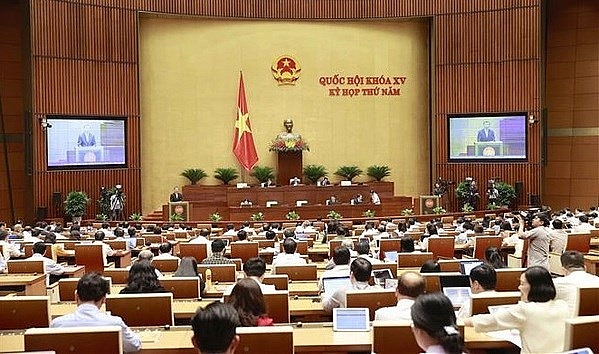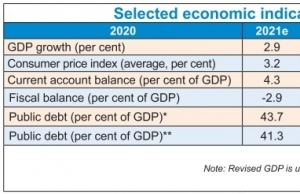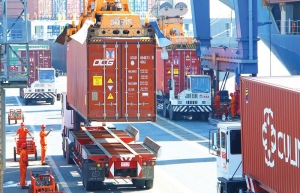Struggling global outlook dampens growth prospects
Chairman of the National Assembly (NA) Vuong Dinh Hue last week urged the government to make new timely measures to assist people and enterprises struggling against prolonged woes.
 |
| An overview of the NA's fifth session. (Photo: VNA) |
“In Q1 of 2023, the country’s economic growth reached a lower-than-expected level of only 3.32 per cent on-year. A number of localities suffered from on-year low or below-zero growth. Meanwhile, the total export-import turnover in many key industrial sectors either dropped or increased at a low level,” Chairman Hue stressed.
He also suggested that solutions must be taken to punishing those who are irresponsible for implementing their assigned tasks, which have undermined the country’s efforts to support people and enterprises and to achieve the desired economic growth of 6.5 per cent this year.
Feeling anxious about the economy’s performance, the NA’s Economic Committee (NAEC) also underscored that the economy is now facing huge difficulties. It recommended that the government take more drastic actions to fuel the economy.
“Many localities which are the country’s key industrial propellants have suffered from below-zero growth. The key driving forces for economic growth such as exports, foreign direct investment (FDI), especially industrial production are on the wane,” the NAEC stated.
“Disbursement of public investment remains at a very slow pace, while four-month newly registered FDI, and newly added FDI, and capital from stake acquisitions and capital contributions hit $8.88 billion, down nearly 18 per cent on-year. Additionally, banks’ lending rates remain at a high level, making it hard for enterprises and people to approach.”
Providing some comment on Q1 economic growth, the NAEC pointed out that the 3.32 per cent rate is “the very low growth level in the context that the economy has fully opened its doors after bringing COVID-19 under control.”
“What is more, this growth level is based on a relatively low growth rate of 5.03 per cent in Q1 of 2022 when the economy was then suffered from social distance and a lockdown against the pandemic in many localities,” the NAEC noted.
“Thus, the data of a 3.32 per cent growth rate in Q1 means that the economy is bogged down in massive difficulties. One of the key reasons is the industrial and construction sector declining 0.4 per cent in Q1, in which almost all industrial sectors, especially the processing and manufacturing sector – the mainstay for economic growth – suffered from a drop,” it continued.
Figures from the General Statistics Office showed that in the first four months of 2023, the mining sector fell 2.8 per cent as compared to the same period last year, when it rose 4.1 per cent on-year. The processing and manufacturing sector also dropped 2.1 per cent on-year, while the same period last year saw an on-year rise of 8.5 per cent. The electricity production and distribution sector only grew 0.5 per cent on-year, versus a 7 per cent climb in the first four months of 2022.
The reductions of these sectors have led to an on-year decrease of 1.8 per cent in the four-month index of industrial production.
According to the Ministry of Construction (MoC), the construction sector grew less than 2 per cent in Q1, with the volume of consumption of some key construction materials witnessed an on-year reduction, such as cement and steel (about 23 per cent), as well as brick, hygiene porcelain, and construction glass (25-30 per cent).
“The main reason is that there has been a slash in domestic consumption and global demand. Domestically, the reduced consumption is ascribed to very slow implementation of projects and works that use much cement and steel such as housing, civil works, bridges, and ports,” the MoC said. “In addition, the grey situation is also put down to the real estate market cooling down.”
“Cutback of employees and delays in payment of salary, insurance, and taxes have become an oft-seen situation in many construction firms,” the MoC added. “A number of contractors, especially small-scaled ones, are on the brink of dissolution and bankruptcy.”
According to the NAEC, the growth prospects in Q2 will struggle to make a breakthrough due to the less optimistic outlook both at home and in the global economy.
| Vu Hong Thanh-Chairman, National Assembly Economic Committee
As of April 25, the credits of the whole economy increased 2.75 per cent on-year, far lower than the on-year climb of 6.75 per cent in the same period last year. In addition, the core inflation expanded 4.9 per cent, higher than the average consumer price index rise of 3.84 per cent on-year. This means that the economy’s production and business situation is facing enormous difficulties, with the capital absorbability of enterprises and the economy continues to face hardships because of high lending rates which have discouraged enterprises from seeking bank loans or the fact that enterprises do not want to have loans as they find it difficult to sell their products. The lending rate recorded a strong increase in 2022 which still stayed at a high level in Q1. According to the government’s report, the new lending rate from banks is now averaged at 9.3 per cent a year, but according to the National Financial Supervisory Committee, the average lending rate of 35 commercial banks as of late March sat at 10.23 per cent a year, which was 0.56 percentage higher than at the end of 2022. |
 | Ambitious 2023 targets out of reach with weak progress A sharp reduction in local production and global demand, coupled with increased geopolitical complexity, are undermining Vietnam’s efforts to achieve its economic growth target for this year. |
 | Slow recovery puts dent in export figures Feeble global demands for consumption are expected to continue, making it hard for Vietnam to boost exports this year. |
What the stars mean:
★ Poor ★ ★ Promising ★★★ Good ★★★★ Very good ★★★★★ Exceptional
Related Contents
Latest News
More News
- New initiative to boost the fight against domestic violence (November 26, 2025 | 10:00)
- South Korea funds IOM relief for Vietnam’s typhoon-affected communities (November 24, 2025 | 15:33)
- AI and human-centred values set to shape the future of HR in Vietnam (November 21, 2025 | 18:04)
- Kimberly-Clark and UNICEF strengthen child and maternal healthcare (November 17, 2025 | 18:08)
- Nestlé expands support for education and active lifestyles in Vietnam (November 17, 2025 | 17:52)
- Swing for the Kids Foundation supports school upgrades in Nghe An’s Do Luong district (November 16, 2025 | 10:00)
- Australia provides further $520,000 in typhoon aid to Vietnam (November 14, 2025 | 17:47)
- EU boosts emergency aid after Typhoon Kalmaegi (November 14, 2025 | 17:42)
- Pfizer Vietnam hosts symposia on pediatric pneumococcal disease (November 14, 2025 | 09:00)
- University of Medicine and Pharmacy develops vaccinology postgrad course (November 11, 2025 | 17:15)


 Tag:
Tag:





















 Mobile Version
Mobile Version